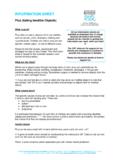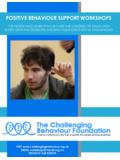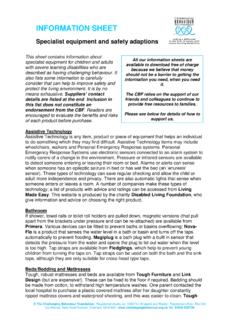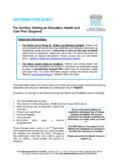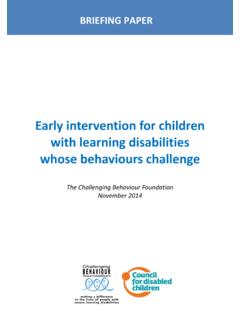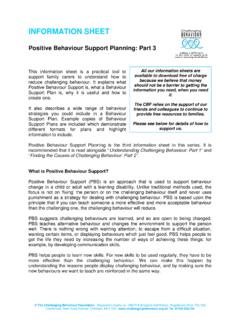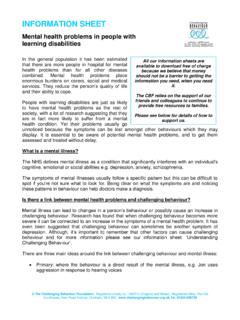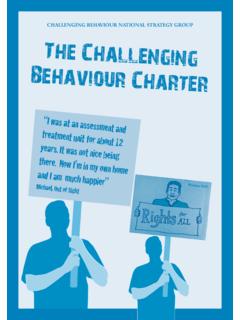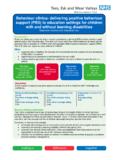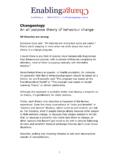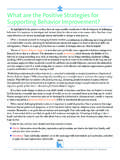Transcription of 01- Understanding Challenging Behaviour Part 1
1 The Challenging Behaviour Foundation. Registered charity no. 1060714 (England and Wales). Registered office: The Old Courthouse, New Road Avenue, Chatham, ME4 6BE. 01634 838739 Peter McGill, Co-director, The Tizard Centre, University of Kent at Canterbury. Understanding Challenging Behaviour is the first information sheet in this series. It is recommended that it is read alongside Finding the Causes of Challenging Behaviour : part 2 and Positive Behaviour Support Planning: part 3 . What is it? The term Challenging Behaviour has been used to refer to the difficult or problem behaviours which may be shown by children or adults with a learning disability. Such behaviours include aggression ( , hitting, kicking, biting), destruction ( , ripping clothes, breaking windows, throwing objects), self-injury ( , head banging, self-biting, skin picking), tantrums and many other behaviours ( running away, eating inedible objects, rocking or other stereotyped movements).
2 Characteristically, Challenging Behaviour puts the safety of the person or others in some jeopardy or has a significant impact on the person s or other people s quality of life. Challenging Behaviour , of course, is not limited to people with learning disabilities but the term has been particularly applied in this context. The severity of Challenging Behaviour can vary greatly. Very serious injury ( blindness, brain damage) can result from some sorts of Behaviour ( eye poking or head banging) and, in such cases, urgent action is required to limit or reverse the effects. In many cases, however, the term is used to refer to Behaviour which does not have such immediately serious consequences but is, nonetheless, very upsetting, disruptive or stressful. In general, Challenging Behaviour is rather more common in people with learning disabilities than in people without disabilities though the pattern varies considerably depending on the type of Behaviour being considered and the age of the people.
3 For example, significant self injury occurs in between 3% and 12% of children attending schools for those with severe learning disabilities and is, therefore, much more common than in children without disabilities where the rate is negligible. Conversely, seriously violent Behaviour (especially involving the use of weapons) is rather less common amongst adults with learning disabilities than other adults. INFORMATION SHEET Understanding Challenging Behaviour : part 1 All our information sheets are available to download free of charge because we believe that money should not be a barrier to getting the information you need, when you need it. The CBF relies on the support of our friends and colleagues to continue to provide free resources to families. Please see below for details of how to support us.
4 ~ 2 ~ The Challenging Behaviour Foundation. Registered charity no. 1060714 (England and Wales). Registered office: The Old Courthouse, New Road Avenue, Chatham, ME4 6BE. 01634 838739 Why does it happen? The first point to make is that there is no simple answer to this question. It is helpful to remember, however, that most people without learning disabilities display lots of Challenging Behaviour very early in their lives. The terrible twos usually don t last but only because most 2-year olds develop a range of communication and social skills which enable them to get what they want and need rather more easily. Many children with learning disabilities do not develop such skills to anything like the same extent and are left with much the same needs as their peers but much less competent ways of getting them met.
5 Such children also may have additional limitations or difficulties which arise directly or indirectly from conditions associated with their learning disability or other impairments. These include, to name some of the more common, autism, sensory impairment and epilepsy. Not being able to see very well, for example, may contribute to the development of eye poking since it is an effective way of generating unusual and interesting visual stimulation. As children grow they also become exposed to at least some of the educational and domestic demands made on other children but are, of course, much less able to handle them. In such circumstances Challenging Behaviour may be a very effective way of escaping from the situation. In the past, and still currently to an extent, society has had rather unusual ways of disposing of people with learning disabilities - such as putting them in large groups in out of the way places.
6 Such institutions have often been characterised by severe social and material deprivation and abuse, factors likely to worsen and in some cases create Challenging Behaviour . Neither are families, schools or other settings immune to such practices, often finding it difficult to respond constructively to the unclear needs of unusual people. In general, then, many cases of Challenging Behaviour appear to be effective ways for a person with learning disability to control what is going on around them. This may reflect their lack of more usual methods of control and the more unusual nature of the environments to which they are exposed. While the above is a generally accepted account of why Challenging Behaviour occurs we should always consider, especially if the Behaviour has just arisen or worsened, the possibility that it reflects some kind of biological or emotional disturbance.
7 Children may bang their heads because their ear aches or hit out because they slept poorly the previous night. Understanding the variation in a person s Challenging Behaviour is often a key to promoting positive change. What can be done? Unfortunately, Challenging Behaviour is not generally like an infection which can be treated by a short-term course of antibiotics. In many cases there will be no magic bullets , change may take some time (especially where the Behaviour is well established), will almost certainly require changes in the way other people behave and may be very susceptible to relapse. Having said all this there is a great deal that can be done to prevent and treat Challenging Behaviour . The goal of prevention is a worthwhile but elusive one. Where Challenging Behaviour arises from a medical condition, a sensory impairment or similar, the ~ 3 ~ The Challenging Behaviour Foundation.
8 Registered charity no. 1060714 (England and Wales). Registered office: The Old Courthouse, New Road Avenue, Chatham, ME4 6BE. 01634 838739 more such conditions can be remedied the better. On an everyday basis carers, parents and teachers can try to ensure that the person has what they need when they need it - help, attention, food, drink, preferred activities and so on. It is very important, however, that people are also given the opportunities and the skills to get things for themselves or to ask for them rather than their always being available on a plate . Without the opportunities of exerting such control people with learning disabilities will be in much poorer positions when they get in to situations (as they inevitably will) where they are expected to fend for themselves and speak up for themselves rather more.
9 One of' the keys to prevention (and also to treatment) is therefore to emphasise the development of communication and independence. If prevention has failed, early intervention is the next best thing. Parents often complain that their attempts to get help early on are met with bland reassurance ( he'll grow out of it ) rather than practical assistance. Of course children do sometimes grow out of' Challenging Behaviour but the histories of adults with serious Challenging Behaviour suggest that their Behaviour generally started at a young age and simply got worse. Parents should, therefore, take their child's Challenging Behaviour seriously especially if it is of a kind not usually found in a child without a learning disability. What can parents do? Getting help is obviously important but where that is not available or slow to arrive parents should consider the following actions: treat the Behaviour as evidence of a previously undetected problem.
10 Is the child in pain? Or bored? Or being asked to do things they find difficult? Or trying to tell you something? And so on. try to check things out for yourself. If you change something does that stop the Behaviour ? Can you teach the child to tell you what they want without Challenging Behaviour ? keep some sort of record of when the Behaviour happens and the things you have done to try to figure out what s going on. In a year or two s time you ll find that it s very difficult to remember the details if (and only if) it is safe to do so then ignore the Behaviour (don t comment on it, don t tell the child off, appear not to notice it) and change the situation (distract, divert) as quickly as you can. If distraction or diversion is impossible you may have to leave the child on their own but you need to be sure that the situation is safe and be able to cope with the Behaviour possibly continuing for some time before it stops if it is not safe to ignore the Behaviour respond as calmly and blandly as possible to prevent the child hurting themselves or others if you do have to respond, better to respond quickly than slowly - otherwise you are teaching the child to be more persistent Challenging Behaviour can be an emotional experience for parents - you may feel very angry with the child or very depressed about their Behaviour .
